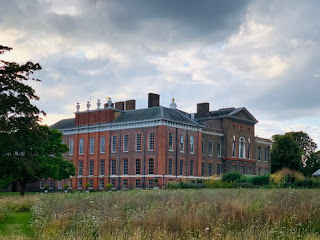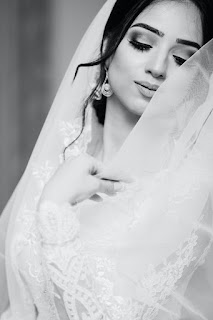Stain-Resistant Clothing
I'm not sure we got to every palace (Buckingham had the longest lines, and was pretty pricey, so we decided to just get a selfie in front of its gates), but we took a stab at it.
Reading Exodus 28 this morning brought my time wandering through Kensington Palace back to mind. Kensington was where Princess Diana had lived until the time of her death, and the part of the palace open for guests allowed for a self-guided tour through a collection of mannequins that showed off many of the princess's gowns.
Each gown was labeled with a title and an occasion where the princess had worn it. Because I'm a nerd, I had previously read about most of these occasions, and so I found the display fascinating. The gowns were dated, of course, but gorgeous in their designs, and I remember randomly thinking: Did Princess Di ever spill milk on her dress? Spaghetti sauce? Red wine? If she had, none of the gowns showed the stains.
We couldn't spend all day at Kensington looking at royal ballgowns, however; my dear husband's eyes were about to roll back in his head. So much as I wished to read more about the history of each piece of clothing, we finished our tour and went out to see the gardens.Exodus 28 gives rich symbolism to clothing pieces. Here is where the Lord tells Moses what the wardrobe of the high priest is going to be, from the turban -- all the way to the underwear. No detail is left out.
There are quite a few pieces that make up the whole outfit: There's that underwear I mentioned, then a woven tunic, a robe, and a blue ephod (which -- from the description -- seems like a collared, lengthy vest that goes on over the rest of the ensemble). There's also a waistband that wraps around all the material, a decorative and functional breastpiece, and a turban for the head.
When I started reading the details about the gems and precious stones used in this outfit, I began wondering just how much the whole costume would weigh. There are two onyx stones (black gems), one for each shoulder; six tribes of Israel are engraved on one stone, six on the other.
That breastpiece was kind of cool. It's nine inches square, and on it are four rows of three gems each. Row 1: ruby, topaz, and beryl, Row 2: turquoise, sapphire, and emerald, Row 3: jacinth, agate, and amethyst, and Row 4, chrysolite, onyx, and jasper. And each of these stones is engraved with one tribe of Israel.Inside that breastpiece is a handy-dandy little pouch where Aaron carries the Urim and the Thummin. The Urim was the first letter of the Hebrew alphabet (aleph), and the Thummin was the last (taw), and they were used to "cast lots." "Thus Aaron will always bear the means of making decisions for the Israelites over his heart before the Lord" (Exodus 28:30).
By this point, Princess Di's ensembles are paling in comparison (due in part, I'm sure, to the decision of the Historic Royal Palaces charity organization not to keep gems and precious stones hanging around in the display cases).
On Aaron-the-high-priest's head, he wears a turban, and on the front of the turban is a gold plate that says: "Holy to the Lord. "It will be on Aaron's forehead, and he will bear the guilt involved in the sacred gifts the Israelites consecrate, whatever their gifts may be. It will be on Aaron's forehead continually so that they will be acceptable to the Lord" (Exodus 28:38).
There are other details about the clothes, but this verse stood out to me. See, the role of the high priest wasn't just to wear fancy gem-set clothing and take care of the Tabernacle/Temple and light the lampstand at night and keep the Bread of the Presence on the table and even to approach the bronze altar and make sacrifices to the Lord.Sure, that was all included in the job description. But the main function of the high priest was to stand in between a sinful nation and a just God and to mediate between the two. All the details of the clothing and of the Tabernacle and all the artifacts in the Tabernacle point to that single, most important, apex factor.
Mediation.
Flip over with me to Hebrews 4:14-15 where the writer of Hebrews gives us the greatest Mediator, far greater than Melchizedek, or Aaron, or Eli, or Caiaphas, or any other high priest mentioned in the Scriptures: "Therefore, since we have a great High Priest who has gone through the heavens, Jesus the Son of God, let us hold firmly to the faith we profess. For we do not have a High Priest who is unable to sympathize with our weaknesses, but we have One [we have One! We are not left defenseless, we are not abandoned! We have a Mediator! Are you excited about this?! I am!] Who has been tempted in every way, just as we are -- yet was without sin (the only High Priest to be so, ever)."
In Daniel 7:13-14, this same High Priest "approached the Ancient of Days and was led into His presence. He was given authority, glory, and sovereign power; all peoples, nations, and men of every language worshiped Him."Keep in mind, the book of Daniel was written long, long before Jesus ever made His appearance on earth, walked it in ministry, died on the cross for us, and was raised to life again. Daniel's writing is prophetic. My kids sometimes pull out the big guns and say: "But how do you know, Mom, that it's all true?" In those instances, besides the evidence of "faith without sight" (Hebrews 11:1), I point to fulfilled prophecy -- prophetic writings from Isaiah and Daniel and others where history takes place exactly as predicted in Scripture. And I tell them, if God took the trouble to fulfill every last, minute detail of prophecy up to the current day except for a very few end-time prophesies yet to happen on the final day when Jesus returns for His bride... do you think He's going to leave out that last important part of His ultimate story?
I don't think so. Everyone repeat after me: "Antiochus Epiphanes IV." Thanks. Go do some research and get blown away by the details.
Now, back to Hebrews 4:16: "Let us then approach the throne of grace with confidence, so that we may receive mercy and find grace to help us in our time of need."
Aaron had to clothe himself in his priestly garments before he could present himself before God as the mediator that stood between a just God and a sinful people. Those garments were essential to the restitution of sin in the Old Covenant, because of the weight of the Lord's holiness.Jesus Himself, our High Priest, is "clothed with splendor and majesty. He wraps Himself in light as with a garment" (Psalm 104:1-2). In Revelation 1:13, He is "dressed in a robe reaching down to His feet and with a golden sash around His chest. His head and hair are white like wool, as white as snow, and His eyes are like blazing fire. His feet are like bronze glowing in a furnace, and His voice is like the sound of rushing waters." In other words, Jesus' clothing trumps Aaron's clothing, because He's the ultimate, sinless Mediator between a just God and sinful humans.
So what do we do with this? Instead of living in those sins that separate us from God, instead of turning away from the Mediator who is standing in our place and advocating for us, we need to turn to Him, wrap ourselves up in HIM. Romans 13:14: "Rather, clothe yourselves with the Lord Jesus Christ, and do not think about how to gratify the desires of the sinful nature."
When we do, we get the white clothes. I've always loved to wear white. I rarely keep spaghetti sauce stains off of my white shirts -- apparently I'm clumsy, and also -- it's white and of course I'm going to get spaghetti sauce stains on it. I'd never have made it as a princess at royal functions.The heavenly white clothing we inherit will be stain-free. Revelation 3:4-5 says: "Yet you have a few people in Sardis who have not soiled their clothes. They will walk with me, dressed in white, for they are worthy. He who overcomes will, like them, be dressed in white. I will never blot out his name from the book of life, but will acknowledge his name before My Father and His angels. He who has an ear, let him hear what the Spirit says to the churches."
And in Revelation 19:8, John writes about the bride of Christ: "For the wedding of the Lamb has come, and His bride has made herself ready. Fine linen, bright and clean, was given her to wear. (Fine linen stands for the righteous acts of the saints.)"
Spaghetti sauce stain free clothes. Bright white clothes. Absolutely clean clothes.









Comments
Post a Comment